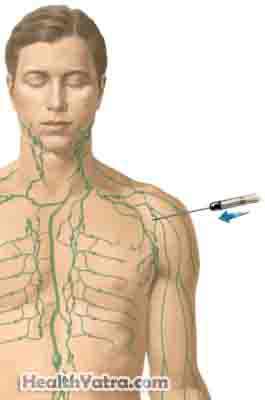Definition
Smallpox is a viral infection. It is contagious and can be deadly. The disease was eliminated worldwide. This was done through global immunization programs. The last known natural occurring human case was in 1977. Governments have studied its use as a germ-warfare weapon. As a weapon, it would be released in the air. Those exposed could develop the disease. They would then pass it to other people.

Causes
Variola major is the virus that causes the infection. It is spread:
- Through the airborne droplets of infected saliva
- Between people who have direct contact
- Through the handling of contaminated bed linens or clothing
Two rare, more serious types of the disease are:
- Hemorrhagic
- Malignant
They are transmitted the same way.
Risk Factors
The main risk factor for contracting smallpox is exposure to the virus after its release during a biological terrorism attack.
Symptoms
Symptoms usually occur about 12 days after exposure. Hemorrhagic or malignant symptoms usually do not appear until death is near.
Early symptoms include:
- High fever
- Fatigue
- Severe headache
- Backache
- Possible stomach pain or delirium
- Fatigue
- Sore throat
- Nausea and vomiting
Two to three days later:
- Rash appears on the mouth, throat, face, and arms, then spreads to the legs and trunk
- Red, flat lesions
- Lesions appear at the same time
- Lesions fill with fluid, then pus
- Crusts form during the second week
- Scabs form and fall off after 3-4 weeks
Hemorrhagic symptoms include:
- High fever
- Fatigue
- Headache
- Backache
- Possible stomach pain
- Dark red coloration
- Bleeding into the skin and mucus membranes
Malignant symptoms include:
- High fever
- Fatigue
- Headache
- Backache
- Slowly developing lesions that remain soft and flat
- Skin looks like reddish-colored crepe rubber
- Large amounts of skin may peel, if the patient survives
Diagnosis
The doctor will ask about your symptoms and medical history. A possible source of exposure will be looked for. A physical exam will be done.
Test may include:
- Examination of saliva and fluid from skin lesions under a microscope
- Taking a sample (a culture) of saliva and fluid from skin lesions
- Blood test to detect antibodies to smallpox
Treatment
No effective treatment for smallpox currently exists. Doctors can offer supportive care. Steps will be taken to prevent spread to others.
Supportive Care
Fluids are given. The skin is kept clean. Medications can help control fever and pain. Antibiotics do not work against viruses. They may be given if other infections develop.
Public Health Measures
Cases are reported to public health officials. A person infected with smallpox should be kept isolated. This will help prevent the spread of infection.
In most cases, family members would provide care at home. Caregivers should:
- Be vaccinated
- Wear a mask, gloves, goggles, and a gown
- Disinfect clothing, bed linens, and surfaces
Patients in the hospital will be placed in a special room. In some cases, forced quarantine may be necessary.
Prevention
Many people were immunized prior to 1972. That protection has likely worn off or decreased. Routine vaccination is not recommended in the US.
An emergency supply of the vaccine is kept. A vaccination within four days of exposure may prevent the disease. It can also make symptoms less severe. Anyone in close contact with a patient after the fever has started should receive the vaccine. Medical and emergency personnel also should be given the vaccine.
Two weeks or more could elapse before the first symptoms occur. The success of an attack would depend on the dose that was inhaled. Experts predict most of the released viruses could live in dry, cool air, without sunlight, for up to a day. Each person infected would likely pass the disease to 10 to 20 other people. Those people, in turn, could spread it to others. The fatality rate in naturally occurring smallpox is 30% or higher.
